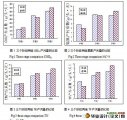异普克对养猪污染减排效果研究

异普克对养猪污染减排效果研究(8100字)
摘 要:异普克是一种能够减少猪场粪污的排放、降低养猪对环境影响的疫苗,目前,国内关于异普克对养猪污染减排效果的研究较少。本论文通过对比异普克去势疫苗猪和传统手术去势猪的粪尿中污染物的含量,对规模化养猪场产生污染物和排放污染物减排效果进行研究。实验结果表明,注射异普克疫苗的公猪,CODCr产污量比传统去势公猪减少11.8%;NH4+-N产污量比之减少16.65%;TN产污量比之减少16.9%;TP产污量比之减少22.4%。因此,公猪注射异普克疫苗,不仅带来了经济效益,更减少了养猪业造成的环境污染, 从而达到生猪养殖业的可持续发展。
关键字:产污量;生猪;异普克
Research on effect of Improvac to pig pollution reduction
Abstract:Imporovac is one kind of vaccine which can reduce the pig farm sewage the emissions, to reduce the influence of raising pigs to the environment. But now,the present research effect to the pig farm pollutant is less.This thesis through contrasts the pollutant contentin the night soil to Imporovac vaccine pig and the traditional surgery castrates, produces the pollutant and the emission pollutant to the formalization pig farm reduces a row of effect to conduct the research.The experimental result indicated that injects Imporovac vaccine the boar, the CODCr pollutant has the coefficient to castrate the boar compared to the tradition to reduce 11.8%; The NH4+-N pollutant has the coefficient to compare it to reduce 16.65%; The TN pollutant has the coefficient to compare it to reduce 16.9%; The TP pollutant has the coefficient to compare it to reduce 22.4%. Therefore, the boar injects Imporovac vaccine, not only has brought the economic efficiency, reduced the environmental pollution which the pig-breeding industry creates, thus achieves the live pig fish breeding and poultry raising the sustainable development.
[资料来源:https://www.doc163.com]
Key words:The coefficient of producing pollution; Pig; Imporovac

目 录
摘 要 1
1 前言 2
2 国内外研究现状 3
2.1 养猪场污染源头控制的主要技术 3
2.1.1 日粮控制 3
2.1.2 应用酶制剂 3
2.1.3 应用微生态制剂 3
2.1.4 应用沸石 4
2.1.5 发酵床 4
2.2 养猪场末端治理的主要技术 4
2.2.1 烘干 4
2.2.2 堆肥化 4
2.2.3 高效厌氧处理 5
2.2.4 物理法 5
2.2.5 化学法 5
2.2.6 生物法 6 [版权所有:http://DOC163.com]
3 材料与方法 6
3.1 实验对象、地点和时间 6
3.2 采样 6
3.3 测定指标 6
3.4 试剂与仪器 7
3.5 产污量核算 7
4 结果与讨论 7
4.1 CODCr产污量的核算 8
4.2 氨氮产污量的核算 8
4.3 TN产污量的核算 8
4.4 TP产污量的核算 8
5 总结 9
参考文献 10
致 谢 11 [版权所有:http://DOC163.com]
